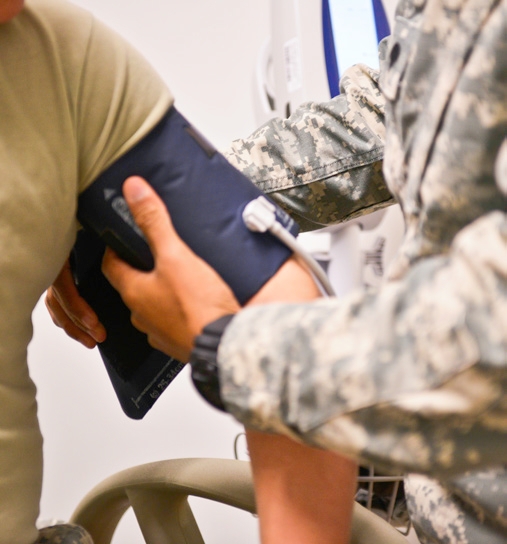Chapter 10. Micronutrients Involved in Fluid and Electrolyte Balance
Hypertension
Hypertension
Blood pressure is the force of moving blood exerted against arterial walls. It is reported as the systolic pressure over the diastolic pressure, which is the greatest and least amount of pressure against an artery with each heartbeat. The force of blood against an artery is measured with a device called a sphygmomanometer. The results are recorded in millimeters of mercury, or mmHg. The desirable blood pressure is around 120/80 mmHg. Hypertension is the scientific term for high blood pressure and is defined as a sustained blood pressure of 140/90 mmHg or greater, and pre-hypertension falls between the two. Hypertension is both a disease itself and a risk factor for other diseases and cardiovascular health outcomes such as the risk of heart attack, as well as coronary artery disease, stroke, heart failure, and kidney failure. Reducing blood pressure has been found to decrease the risk of dying from a heart attack or stroke.

Sodium and Hypertension
There has been much debate about the role sodium plays in hypertension. In the late 1980s and early 1990s, the largest epidemiological study evaluating the relationship of dietary sodium intake with blood pressure, called INTERSALT, was completed and then went through further analyses.[1][2] More than ten thousand men and women from thirty-two countries participated in the study. The study concluded that a higher sodium intake is linked to an increase in blood pressure. A more recent study, involving over twelve thousand US citizens, concluded that a higher sodium-to-potassium intake is linked to higher cardiovascular mortality and all-causes mortality.[3]
The DASH-Sodium trial was a clinical trial which evaluated the effects of a specified eating plan with or without reduced sodium intake. The DASH diet is a diet plan low in saturated fat, cholesterol, and total fat. Fruits, vegetables, low-fat dairy foods, whole-grain foods, fish, poultry, and nuts are emphasized while red meats, sweets, and sugar-containing beverages are mostly avoided. In this study, people on the low-sodium (1500 milligrams per day) DASH diet had mean systolic blood pressures that were 7.1 mmHg lower than people without hypertension not on the DASH diet. The effect on blood pressure was greatest in participants with hypertension at the beginning of the study who followed the DASH diet. Their systolic blood pressures were, on average, 11.5 mmHg lower than participants with hypertension on the control diet.[4] Following the DASH diet not only reduces sodium intake, but also increases potassium, calcium, and magnesium intake. All of these electrolytes have a positive effect on blood pressure, although the mechanisms by which they reduce blood pressure are largely unknown.
Collectively, there appears to be a consensus that high sodium intake is detrimental to health and that reducing sodium has beneficial effects, particularly in those with blood pressures above average values.[5] Reducing sodium intake not only has hypotensive effects and reduces one’s risk of developing hypertension, but is also associated with reduced cardiovascular morbidity and mortality.[6] Those with blood pressure < 120/80 mmHg gain the least benefit from lowering sodium intake.[7]
Salt Sensitivity
High dietary intake of sodium is one risk factor for hypertension and contributes to high blood pressure in many people. However, studies have shown that not everyone’s blood pressure is affected by lowering sodium intake. Salt sensitivity affects nearly 25% of people with normal blood pressure and 50% of those with hypertension, which means that blood pressure is affected by salt intake.[8] Genetics, race, sex, age, body mass index, and physical activity level are all factors that contribute to salt sensitivity.[9]. Black Americans, women, and overweight individuals are more salt-sensitive than others. Also, if hypertension runs in a person’s family, that person is more likely to be salt-sensitive.
Media Attributions
- Measuring blood pressure © Charlie Helmholt is licensed under a Public Domain license
- Intersalt Cooperative Research Group. Intersalt: An International Study of Electrolyte Excretion and Blood Pressure. Results for 24 Hour Urinary Sodium and Potassium Excretion. BMJ. 1988; 297(6644), 319–28. http://www.ncbi.nlm.nih.gov/pmc/articles/PMC1834069/. Accessed September 20, 2017. ↵
- Elliott P, Stamler J, et al. Intersalt Revisited: Further Analyses of 24 Hour Sodium Excretion and Blood Pressure within and across Populations. BMJ. 1996; 312(7041), 1249–53. http://www.ncbi.nlm.nih.gov/pubmed/8634612. Accessed September 22, 2017. ↵
- Yang Q, Liu T, et al. Sodium and Potassium Intake and Mortality among US Adults: Prospective Data from the Third National Health and Nutrition Examination Survey. Arch Intern Med. 2011; 171(13), 1183–91. https://www.ncbi.nlm.nih.gov/pubmed/21747015. Accessed September 22, 2017. ↵
- Sacks, FM, Svetkey LP, et al. Effects on Blood Pressure of Reduced Dietary Sodium and the Dietary Approaches to Stop Hypertension (DASH) Diet. N Engl J Med. 2001; 344(1), 3–10. http://www.ncbi.nlm.nih.gov/pubmed/11136953. Accessed September 22, 2017. ↵
- Cook NR, He FJ, MacGregor GA, Graudal N. Sodium and health—concordance and controversy. BMJ. 2020 Jun 26;m2440. ↵
- Grillo A, Salvi L, Coruzzi P, Salvi P, Parati G. Sodium Intake and Hypertension. Nutrients. 2019 Aug 21;11(9):1970. doi: 10.3390/nu11091970. PMID: 31438636; PMCID: PMC6770596. ↵
- Cook NR, He FJ, MacGregor GA, Graudal N. Sodium and health—concordance and controversy. BMJ. 2020 Jun 26;m2440. ↵
- Maaliki D, Itani MM, Itani HA. Pathophysiology and genetics of salt-sensitive hypertension. Front Physiol. 2022 Sep 13;13. ↵
- Maaliki D, Itani MM, Itani HA. Pathophysiology and genetics of salt-sensitive hypertension. Front Physiol. 2022 Sep 13;13. ↵

